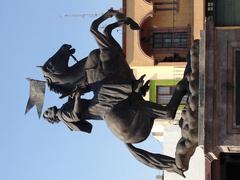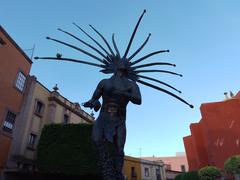Visiting The Flutist Sculpture in Santiago de Querétaro, Mexico: Complete Guide with Tickets, Hours, and Tips
Date: 14/06/2025
Introduction
Nestled in the UNESCO-listed historic center of Santiago de Querétaro, The Flutist (El Flautista) is a contemporary bronze sculpture by the acclaimed Mexican artist Jorge Marín. This guide provides comprehensive information for those planning a visit—covering the sculpture’s artistic and cultural significance, practical visitor tips, accessibility, guided tours, and how to best enjoy Querétaro’s vibrant historic heart.
Contents
- Introduction
- Historical and Artistic Context
- Location and How to Get There
- Visiting Hours and Admission
- Accessibility and Amenities
- Best Times to Visit
- Guided Tours and Events
- Artistic Description of The Flutist
- Nearby Attractions
- Photography Tips
- Community and Cultural Life
- Safety and Visitor Etiquette
- Frequently Asked Questions (FAQ)
- Conclusion & Recommendations
- Sources and Further Reading
Historical and Artistic Context
Querétaro’s Heritage and Modern Public Art
Santiago de Querétaro is renowned for its blend of baroque and neoclassical architecture, lively plazas, and deep cultural traditions dating back to the 16th century (UNESCO). The city’s Centro Histórico, a UNESCO World Heritage Site, is characterized by cobblestone streets and a legacy of public performances. In recent decades, Querétaro has championed the integration of modern public art into its historic core. The Flutist, installed as part of this urban initiative, reflects the city’s evolving dialogue between colonial heritage and contemporary creativity (Travel With Intention, Hay Festival).
The Flutist’s Symbolism
The Flutist honors Querétaro’s musical tradition and its vibrant street life. The sculpture, featuring a woman playing the flute, evokes harmony, artistic expression, and the everyday celebration of music within local culture. It stands as a symbol of the city’s commitment to creative expression and public art (El Clima).
Location and How to Get There
The Flutist is located at the intersection of Calle Vergara Sur and Libertad, next to the bustling city market—an area surrounded by colonial-era buildings, shops, and cafes (Nicki Posts Travel Stuff, Mapcarta). It is also easily accessible from Andador 5 de Mayo, a popular pedestrian corridor connecting major plazas and cultural sites (Backpacking Brunette).
Getting There:
- Walking: The sculpture is within walking distance from most hotels and attractions in the historic center.
- Public Transport: City buses, taxis, and rideshare services (Uber, Didi) are readily available.
- Parking: Public parking lots are nearby; however, spaces can be limited during peak hours.
Visiting Hours and Admission
- Hours: The Flutist is in a public plaza and is accessible 24/7. For the best experience, visit during daylight hours (8:00 AM – 7:00 PM) when the sculpture and surrounding architecture are most visible.
- Admission: Free of charge; no tickets required (TripSavvy).
Accessibility and Amenities
- Accessibility: The area is pedestrian-friendly, with smooth pathways, benches, and shaded spots. While most routes are accessible, historic cobblestone streets may pose minor challenges for wheelchairs or strollers; assistance is recommended in some areas (Backpacking Brunette).
- Amenities: Public restrooms (occasionally for a small fee), ATMs, cafes, and artisan shops are all close by. The adjacent city market offers a taste of local flavors and crafts.
Best Times to Visit
- Morning: Enjoy tranquil surroundings and soft light for photography.
- Late Afternoon/Evening: Experience the lively ambiance as locals and tourists gather; ideal for capturing Querétaro’s vibrant street life.
- Festivals: Major cultural events (e.g., Festival Internacional de Artes Escénicas, Day of the Dead) infuse the area with performances and markets (Mexico Travel Secrets).
Querétaro enjoys mild weather year-round, but the dry season (November–April) is particularly pleasant for outdoor activities (Mexico’s Magic Destinations).
Guided Tours and Events
Guided walking tours (available in Spanish and English) often feature The Flutist alongside other historic and artistic sites. These tours offer rich context about the sculpture and Querétaro’s cultural tapestry. Booking in advance is recommended, especially during peak seasons or festivals (The Crowded Planet).
The plaza around The Flutist regularly hosts cultural happenings—music, dance, art walks, and educational workshops, further enhancing the visitor experience (Life on the Roam).
Artistic Description of The Flutist
Jorge Marín’s sculpture depicts a woman playing a flute, perched gracefully on a stone. The flowing lines of her dress and the lifelike pose capture both movement and serenity. The piece is cast in bronze, ensuring durability and a timeless visual appeal. Its style bridges traditional craftsmanship and modern design, resonating with Querétaro’s mix of historic and contemporary aesthetics (Nicki Posts Travel Stuff).
Nearby Attractions
Enhance your visit by exploring these nearby landmarks:
- Museo de los Conspiradores: Insight into Mexico’s independence movement.
- Casa de la Corregidora: Historic government building.
- Galería Libertad: Contemporary art exhibitions.
- Plaza de Armas & Jardín Zenea: Iconic plazas ideal for people-watching.
- Templo de Santa Rosa de Viterbo: Baroque church masterpiece (adventurebackpack.com).
The surrounding market and artisan stalls are perfect for sampling local cuisine and purchasing unique crafts (Nomads Beyond).
Photography Tips
- Best Light: Early morning and late afternoon provide warm, soft lighting.
- Angles: Capture the sculpture’s details and the vibrant colonial backdrop.
- Ethics: Ask permission before photographing vendors or performers; support them with a small purchase (Backpacking Brunette).
Community and Cultural Life
The Flutist is a community focal point—used as a backdrop for festivals, concerts, and art events. It fosters public engagement with the arts, and educational institutions often include it in cultural tours or art appreciation programs (queretaro.gob.mx, de.wikipedia.org).
Safety and Visitor Etiquette
- Safety: Querétaro is considered one of Mexico’s safest cities. The historic center is well-lit and patrolled. Stay aware of your belongings in crowded areas (Houstonia Mag).
- Etiquette: Respect the artwork—do not climb or deface it. Dispose of trash properly and maintain a respectful demeanor during festivals and performances.
Frequently Asked Questions (FAQ)
Q: What are The Flutist’s visiting hours?
A: The sculpture is accessible 24/7; daylight hours are best for viewing and photography.
Q: Is there a ticket or entrance fee?
A: No, visiting The Flutist is free.
Q: Is the area accessible for people with disabilities?
A: Yes, but cobblestone streets may require some assistance.
Q: Are guided tours available?
A: Yes, many tours (in English and Spanish) include The Flutist as a highlight.
Q: Can I take photographs?
A: Yes, photography is encouraged. Be courteous when photographing people.
Q: What nearby attractions should I include in my itinerary?
A: Plaza de Armas, Museo de los Conspiradores, Casa de la Corregidora, and the city market are all within walking distance.
Conclusion & Recommendations
The Flutist stands as a vibrant emblem of Querétaro’s artistic vitality and deep-rooted musical traditions. With its central location, free and easy access, and proximity to major historical sites, it is a must-see for anyone exploring the city. Enhance your visit by joining a guided tour, attending a nearby festival, or simply enjoying the dynamic street life of the historic center. For real-time updates, event information, and detailed maps, download the Audiala app and consult the official city cultural portals.
Sources and Further Reading
- Travel With Intention
- UNESCO
- Hay Festival
- TripSavvy
- Nicki Posts Travel Stuff
- Mapcarta
- El Clima
- The Crowded Planet
- Life on the Roam
- Houstonia Mag
- Backpacking Brunette
- Roaming Around the World
- Mexico’s Magic Destinations
- Mexico Travel Secrets
- Querétaro Government




